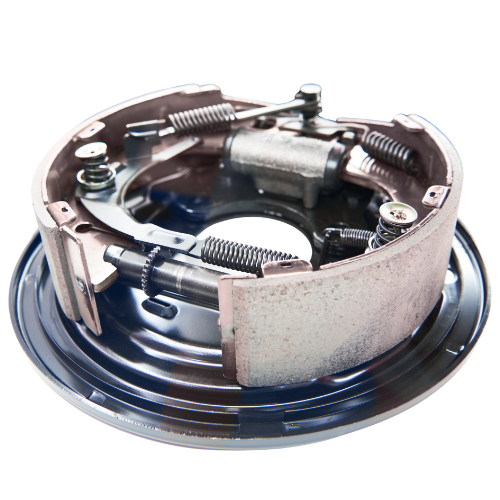Explore the four key components that make up a truck’s brake system—engineered to ensure safe, reliable, and powerful stopping performance on every road.

For modern trucks, the system includes several key parts working together—brake calipers, air brakes, brake chambers, slack adjusters, and brake shoes—to deliver reliable and powerful stopping power.
Brake calipers, while more commonly associated with disc braking systems, are becoming increasingly prevalent in commercial transport. As vehicle technology evolves, understanding how calipers fit into the broader braking setup is useful for truck owners, fleet operators, and even workshop technicians.
This guide offers a straightforward, beginner-friendly explanation of the function of brake calipers, how they interact with other key parts like brake chambers and slack adjusters, and what to look out for when checking for wear.
In simple terms, a brake caliper is a mechanical component that houses the brake pads and applies pressure to the brake disc (or rotor) when you press the brake pedal. It forms a vital part of a disc brake system. In trucks, especially newer models or vehicles fitted with American axle configurations, disc brakes are becoming a popular alternative to traditional drum brakes.
Brake calipers squeeze the disc with the brake pads, using either hydraulic or air pressure, to create the friction that slows or stops the vehicle. In heavy trucks, this process needs to be precise and powerful due to the weight and load these vehicles carry.
Although many commercial trucks still use drum brakes—particularly those involving brake shoes, brake chambers, and slack adjusters—disc brake systems are gaining traction for their:
• Faster heat dissipation
• More consistent performance under heavy loads
• Lower maintenance intervals in certain applications
In trucks with air disc brakes, the braking process starts similarly:
The shift toward using brake calipers in heavy-duty applications isn’t just a trend—it comes with real benefits:
• Improved braking performance: Especially noticeable during downhill driving or when hauling heavier loads.
• Better heat management: Disc systems cool faster than drums, reducing brake fade.
• Easier inspection and replacement: Technicians can visually inspect disc brakes without removing major components.
• Enhanced safety: Calipers often offer more even braking, helping maintain vehicle stability.
These advantages make calipers particularly appealing in applications like long-haul transport, urban freight, or modern E-Vehicles designed with regenerative and disc-based systems.
Even in vehicles where calipers are primary, they still work in tandem with parts like:
• Brake chambers: These generate the mechanical force that activates calipers in air disc brake systems.
• Slack adjusters: Though mostly found in drum setups, some disc systems may use variants for adjusting lever arms or tension in mechanical linkages.
• Brake shoes: These are exclusive to drum brakes, but knowing the difference helps you understand which system you’re dealing with.
• Brake line bender: While not directly related to calipers, this tool is essential in maintaining or installing brake lines that feed calipers and chambers.
Together, these components form a complete and responsive system. Regular servicing ensures all parts communicate effectively—something a qualified workshop or technician can handle with ease.
While brake calipers are sturdy and built to last, they do wear out over time. Common signs include:
• Uneven braking: The truck pulls to one side under braking.
• Brake fade or overheating: Reduced performance after continuous use.
• Sticking caliper: One brake may drag or stay engaged, causing excess wear.
• Visible fluid leaks: In hydraulic systems, fluid near the caliper signals a seal issue.
• Unusual noises: Grinding or squealing often points to pad or caliper issues.
It’s important not to ignore these symptoms. Replacing calipers promptly prevents damage to rotors and other brake components, keeping your truck safer and more reliable.
To extend the life of your brake calipers and surrounding parts:
• Schedule routine inspections: Don’t wait for a problem—check calipers during brake pad or tyre replacements.
• Monitor brake performance: Changes in pedal feel, noise, or stopping power are early warnings.
• Use high-quality parts: Source replacements from trusted suppliers and ensure they match your vehicle’s requirements, whether it’s a brake chamber, slack adjuster, or brake caliper.
• Replace in pairs: To ensure even braking, calipers are best replaced in axle pairs.
Understanding how brake calipers function in modern truck braking systems gives you an edge in maintaining vehicle safety and performance. As more fleets adopt air disc brakes—especially in newer trucks and E-Vehicles—calipers are becoming a more visible and critical component.
Although they may not require attention as often as pads or brake shoes, calipers shouldn’t be overlooked. Simple inspections, paired with timely maintenance, help ensure your truck stays roadworthy and responsive under pressure. Choosing quality parts from reliable truck part supplier and staying informed is key to running a safe and efficient operation.